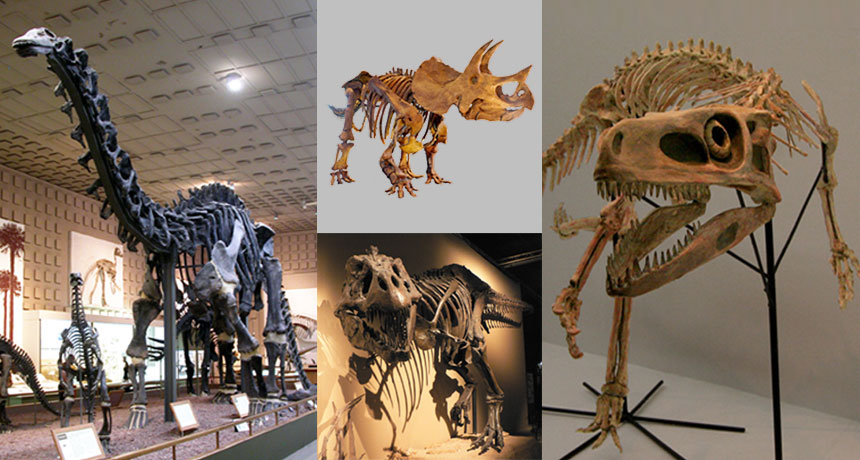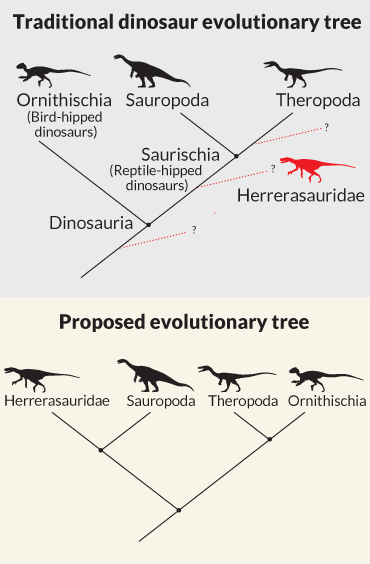Anatomy analysis suggests new dinosaur family tree
Proposal would radically alter century-old groupings

NEW WAY TO RELATE The dinosaur evolutionary tree just got a makeover. One outcome of the proposed rearrangement is that meat-eating evolved twice in dinosaurs (in groups represented by Tyrannosaurus rex, bottom middle, and Staurikosaurus, right), as did traits associated with plant-eating (groups represented by Brontosaurus, left, and Triceratops, top middle).
Clockwise from left: Matt Wedel/Wikimedia Commons (CC BY 4.0); Allie_Caulfield/Wikimedia Commons (CC BY-SA 3.0); Kabacchi/Wikimedia Commons (CC By 2.0); David Monniaux/Wikimedia Commons (CC By-SA 2.0 FR)
The standard dinosaur family tree may soon be just a relic.
After examining more than 400 anatomical traits, scientists have proposed a radical reshuffling of the major dinosaur groups. The rewrite, reported in the March 23 Nature, upsets century-old ideas about dinosaur evolution. It lends support to the accepted idea that the earliest dinosaurs were smallish, two-legged creatures. But contrary to current thinking, the new tree suggests that these early dinosaurs had grasping hands and were omnivores, snapping up meat and plant matter alike.
“This is a novel proposal and a really interesting hypothesis,” says Randall Irmis, a paleontologist at the Natural History Museum of Utah and the University of Utah in Salt Lake City. Irmis, who was not involved with the work, says it’s “a possibility” that the new family tree reflects actual dinosaur relationships. But, he says, “It goes against our ideas of the general relationships of dinosaurs. It’s certainly going to generate a lot of discussion.”
The accepted tree of dinosaur relationships has three dominant branches, each containing critters familiar even to the non–dinosaur obsessed. One branch leads to the “bird-hipped” ornithischians, which include the plant-eating duckbills, stegosaurs and Triceratops and its bony-frilled kin. Another branch contains the “reptile-hipped” saurischians, which are further divided into two groups: the plant-eating sauropods (typically four-legged, like Brontosaurus) and the meat-eating theropods (typically two-legged, like Tyrannosaurus rex and modern birds).
This split between the bird-hipped and reptile-hipped dinos was first proposed in 1887 by British paleontologist Harry Seeley, who had noticed the two strikingly different kinds of pelvic anatomy. That hypothesis of dinosaur relationships was formalized and strengthened in the 1980s and has been accepted since then.
The new tree yields four groups atop two main branches. The bird-hipped ornithischians, which used to live on their own lone branch, now share a main branch with the reptile-hipped theropods like T. rex. This placement suggests these once-distant cousins are actually closely related. It also underscores existing questions about the bird-hipped dinos, an oddball group with murky origins; they appear late in the dinosaur fossil record and then are everywhere. Some scientists have suggested that they evolved from an existing group of dinosaurs, perhaps similarly herbivorous sauropods. But by placing the bird-hipped dinos next to the theropods, the tree hints that the late-to-the-party vegetarian weirdos could have evolved from their now close relatives, the meat-eating theropods.
Sauropods (like Brontosaurus) are no longer next to the theropods but now reside on a branch with the meat-eating herrerasaurids. Herrerasaurids are a confusing group of creatures that some scientists think belong near the other meat eaters, the theropods, while others say the herrerasaurids are not quite dinosaurs at all.
The new hypothesis of relationships came about when researchers led by Matthew Baron, a paleontologist at the University of Cambridge and Natural History Museum in London, decided to do a wholesale examination of dinosaur anatomy with fresh eyes. Using a mix of fossils, photographs and descriptions from the scientific literature, Baron and colleagues surveyed the anatomy of more than 70 different dinosaurs and non-dino close relatives, examining 457 anatomical features. The presence, absence and types of features, which include the shape of a hole on the snout, a cheekbone ridge and braincase anatomy, were fed into a computer program, generating a family tree that groups animals that share specialized features.
In this new interpretation of dinosaur anatomy and the resulting tree, many of the earliest dinosaurs have grasping hands and a mix of meat-eating and plant-eating teeth. If the earliest dinos were really omnivores, given the relationships in the new four-pronged tree, the evolution of specialized diets (vegetarians and meat eaters) each happened twice in the dinosaur lineage.
When the researchers saw the resulting tree, “We were very surprised — and cautious,” Baron says. “It’s a big change that flies in the face of 130 years of thinking.”
The arrangement of the new tree stuck even when the researchers fiddled around with their descriptions of various features, Baron says. The close relationship between the bird-hipped, plant-eating ornithischians and the reptile-hipped, meat-eating theropods, for example, isn’t based on one or two distinctive traits but on 21 small details.
“The lesson is that dinosaur groups aren’t characterized by radical new inventions,” says paleontologist Kevin Padian of the University of California, Berkeley. “The relationships are read in the minutiae, not big horns and frills.” That said, Padian, whose assessment of the research also appears in Nature, isn’t certain that the new tree reflects reality. Such trees are constructed based on how scientists interpret particular anatomical features, decisions that will surely be quibbled with. “The devil is in the details,” Padian says. “These guys have done their homework and now everyone’s going to have to roll up their sleeves and start checking their work.”








